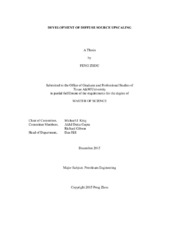| dc.description.abstract | Recently, a novel diffuse source (DS) upscaling method has been successfully applied for the upscaling of US tight gas reservoir model. However, this approach does not work very well in the conventional SPE10 waterflood reservoir model. Therefore, in this work, the goal is to figure out why this approach does not work in another model and how to improve this DS upscaling algorithm.
Detailed analysis shows that there are three issues that need to be resolved for a more robust algorithm. The first issue is about the specification of the diffuse source time that is needed to define the transient state diffuse source in the fine cell. In the previous work, the time selection rule is not clearly stated. Too small or too large time values can lead to an overestimated or underestimated upscaling result. In this study, I find that the diffuse source time can be correlated with the fine cell diffusive time of flight (DTOF). By means of a series of sensitivity test, I get the conclusion that we can use the pore volume weighted average of the DTOF square to determine the diffuse source time.
The second issue is related to the calculation of the effective transmissibility. In the case of upscaling the homogenous model, the previous proposed effective transmissibility calculation method gives us a wrong result. In this study, by studying the internal pressure profile in the coarse cells, I propose to use the fine cell pressures immediately adjacent to the coarse cell interface to determine an effective face permeability and apply the effective permeability to the calculation of steady state transmissibility in the simulator. The effective transmissibility obtained from this method is correct when the model is homogenous.
The third issue has to do with the no flow boundary condition used in the local upscaling. In upscaling, we often encounter such problem that the no flow boundary condition is a bad approximation and to improve the accuracy of the result, we need to consider the existence of boundary effect. In this study, I generalize the DS upscaling algorithm by adding a buffering region around the upscaling coarse cells to reduce the impact of unrealistic boundary condition on the inter-cell effective transmissibility calculation. The buffering region is determined according to the fine cell DTOF in the target coarse cells and by using the exponential function in the diffuse source term, I propose a cut-off criterion to exclude the cells that are not necessary for upscaling.
Based on all the analysis above, I applied an improved upscaling algorithm for the upscaling of the SPE10 model. It turns out that the simulation results from the new upscaled model have a good match with the fine scale results, which gives us the confidence on this improved algorithm. | en |


